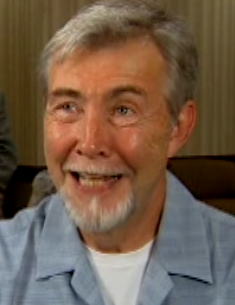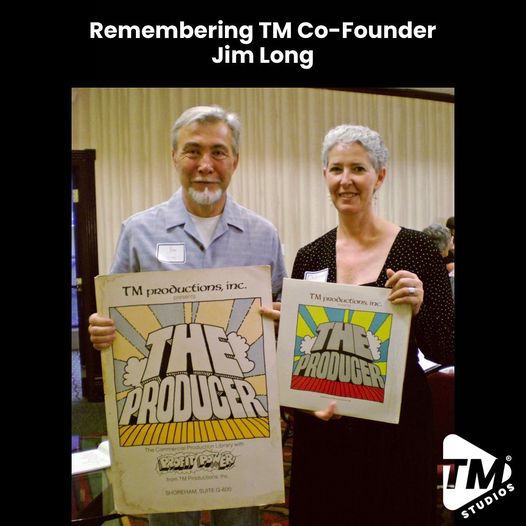
Jim Long, one of
the co-founders (along with Tom Merriman) of the legendary TM
Productions, passed away on May 30, 2022. He was 79.
In remembrance of
this incredible friend of broadcasting, we're sharing this
chapter about Long from Ken Deutsch's Second
Jingle Book.
Long On Jingles
What an explosive
year 1969 was.
In April the 5th Dimension released a song that spoke for the
young generation, "Aquarius/Let the Sun Shine In." On July 20 we
watched Neil Armstrong walk on the moon. The youth movement
broke loose Aug. 15-17 as a half million people gathered at Max
Yasgur's farm near White Lake, N.Y., for a celebration called
Woodstock.
It was while these events were unfolding that musical arranger
Tom Merriman joined businessman Jim Long to form TM Productions
in Dallas. In the 1970s, TM would become a powerhouse in
jingles, music libraries, automated formats and radio specials.
Long had worked with music libraries and jingles as a program
director in his radio days prior to joining Merriman. He had
purchased jingles from CRC and Gwinsound, both in Dallas, and
gained experience with production libraries created by New York
producer Mark Century and from CRC, Merriman's former
enterprise. Also in Long's production arsenal was the "Capitol
Cue Library," produced by Capitol Records in Los Angeles.
"I met Tom Merriman when he was a freelance arranger and I was
writing lyrics for Gwinsound," Long said. "Merriman's the guy
who gave me my first real opportunity outside of broadcasting.
He got me a job as executive producer at CRC so that we could
work on a project together.
"The first ID package we worked on was Series 47, 'Ratings
Grabber.' Man, we borrowed heavily from Chuck Blore, who was a
creative guru and occasional jingle producer. But we tried some
different techniques with brass and vocal sounds."
While this was going on, Long and Merriman talked. CRC was
headed into shaky financial territory. Long had been formulating
ideas for production libraries and ID packages since working in
radio. Within a year of their collaboration, the men decided to
create a new company and call it TM Productions. Jim Long was a
"radio name." His real name was Tim Moynihan, so he and Merriman
had the same initials.
"We started off by creating radio ID jingles so we could get
some cash flow," Long said. "It was tough for the first couple
of years. We never had a lot of funds to build the company.
"Luckily, Tom also had a salaried position as music director at
a private school in Dallas. At first, TM consisted of just Tom,
myself and a woman named Joyce Kilmer. All of us were from CRC,
and all we had at the start was smoke and mirrors."
Talk about humble origins. This small crew operated out of the
back of an auto body shop on Dyer Street near the old Summit
Sound, which backed up to a fertilizer plant. The same building
had housed Futursonic and CRC.
"It wasn't pretty, but we rebuilt the studios and it worked for
us," said Long.
The distinctive and almost medieval TM logo that appeared on
early tape boxes was inspired by ... a hot dog. "It came from
the menu of a kosher deli called Phil's in Dallas," said Long.
"I liked the interesting type font they had for their Wisner
Kosher Hot Dogs, so we used it."
Long took his budding company into syndication of automated
formats, supplied to radio stations on 10-inch reels. This move
helped solidify his new firm.
"IDs were not a terrific business at that time," Long said. "A
lot of stations were just buying shotgun jingles. We were
selling ID packages for the same money ($2,500-$3,500) as when I
had been a PD. Talent and production expenses were increasing,
but profits were getting smaller. That's how libraries and
automated programming became the core of our business."
At this point, others had already entered the field of music
formats, including Stereo Radio Productions, but Long was able
to make a deal to distribute the programming of beautiful-music
station WDOK(FM), Cleveland.
"The problem was that their tapes wouldn't duplicate because the
tones weren't put on them properly, so we had to rebuild the
whole library in a hurry," he said. "And we had all these
stations signed up."
Within several years, TM released two successful production
libraries on vinyl, "The Producer" and "Masterplan." Others
would follow.
"We would produce these demos and pre-sell whatever we were
doing; and if we got enough contracts we knew we were onto
something," he said. "Then we constantly tested with our clients
to see what they wanted most."
TM's willingness to test-market its products paid off. During
the 1970s the staff grew to more than 50.
Political intrigue
While the jingles were percolating, much corporate maneuvering
was taking place. TM was bought and sold. Promises were broken.
Plans were dashed.
"Starr Broadcasting owned TM at the time," Long said. "They
promised to sell the company back to us and reneged on the deal.
We had plans to become one of the first syndication companies to
use satellite to distribute the formats back in 1978 and 1979.
That was kind of the end of TM for me, frankly."
Long had a contract to be president for five years, and lasted
less than three months.
"The company had been entrepreneurial, and they wanted to impose
a lot of rules on us," he said. "They were also pretty highly
leveraged and didn't want to invest the money to take us from a
production company to a media company."
Long left and started FirstCom in 1980. A number of key people
followed him from TM.
"We brought in sales people and also a brilliant
producer-operations guy named Ken Justiss, a rock you could
build a church on," he said. "We produced some IDs but focused
on a commercial library called 'The Creative Department.' By the
mid-1980s we were heavily involved with music for TV shows and
motion pictures. I'm still in that business today."
FirstCom produced the first CD production library in 1984 and
continued to sell to radio and TV stations, as well as TV and
film producers. Long sold FirstCom in 1991 to Zomba-Jive
Records, and that company has been sold again. FirstCom still
distributes music produced by Long's company, OneMusic.
Jim Long had the vision to see himself as a broadcast supplier
rather than simply a maker of jingles.
"I found that just producing pure IDs was not profitable. Ten
years after I bought jingles for the stations I programmed in
medium markets, we were still selling them at TM for the same
price. The math just doesn't work," he said.
Long was a bottom-line manager, but he was respected by his
employees.
"TM paid everybody what they were supposed to get, when they
were supposed to get it," he said. "There is a perception within
a small community of talented people that if you have problems
in that area, you take the gloss off your company."
In the 1960s and 1970s there was little royalty income made on
jingles and libraries. In fact, it came as a big surprise when
Tom Merriman received a series of royalty checks from the Mutual
Broadcasting Network for some themes he had written. Merriman
split the money with Long.
"When you licensed product exclusively in North America, you
couldn't collect royalties," Long said. "As soon as we got past
the non-exclusive barrier we started to make it work."
Now that audio-watermarking technology is available, companies
like OneMusic are able to realize more "back-end" profit from
library music. Watermarking is a technical trick that allows the
producer of a CD to embed coded information into the music to
identify the composer and provide other copyright information.
Thanks, Tom
Long never imagined that TM would grow as big as it did. "It was
a great time and I stay in touch with many of my former
associates," he said. "I owe everything to Tom Merriman. He gave
me a shot and then let me alone."
Merriman was also "instrumental" in the careers of other Dallas
talent.
"He was generous with a lot of writers, people who now have big
careers," Long said. "For example, Tom insisted we hire a high
school kid named Chris Kershaw as a gopher one summer. Chris was
the worst gopher I have ever seen. But Tom saw the potential
there, and he was right."
Kershaw went on to a huge career in the Dallas jingle industry,
working for PAMS, TM, Tanner, Sundance, Gwinsound, JAM Creative
Productions and many others. He also had his own companies:
Music-K Productions and Kershaw-West, the latter in partnership
with Jim West.
While some of the most important people in the Dallas jingle
scene were writers and musicians, Jim Long was successful and
gained respect as a top manager and strategist. He saw trends
before others and never let his personal tastes interfere with
what he knew would work in the marketplace.
"It's all good if it sells," he said.
For more great reading about
the radio jingle industry, check our Ken Deutsch's two jingle
books, part of JingleSampler.com's Big Book
Bonanza.
TM Studios posted
this on their
Facebook page on June 1, 2022.

Itís with profound
sadness that we announce the passing of another icon in TMís 55
Year history - Jim Long (aka Timothy Moynihan, aka the other TM
of TM Studios). He was best known for his eagle eye in spotting
a gap in the market, which led to TM quickly becoming a leader
in jingles, music libraries, and programming for radio stations
around the world. Jim invented the shotgun and the image song
and revolutionized how jingles worked on air.
Jim was always
proud to be at the cutting edge of the radio industry, and
everyone claimed he had the "Midas touch." Jim went on to launch
Firstcom Music and had many other successful ventures after his
days at TM.
To this day, Jimís
vision, passion, and business acumen is shared through the halls
of TM and by the current TM Studios ownership.
TMís Dave Bethell
spoke to Jim this past Friday, and his passion and love for TM
appeared as fresh as it was the day Jim and partner Tom Merriman
opened the doors.
At this difficult
time, we send our heartfelt condolences to Jimís family and
friends and to those who knew him or worked with him over the
years.
Jim Long on
Wikipedia